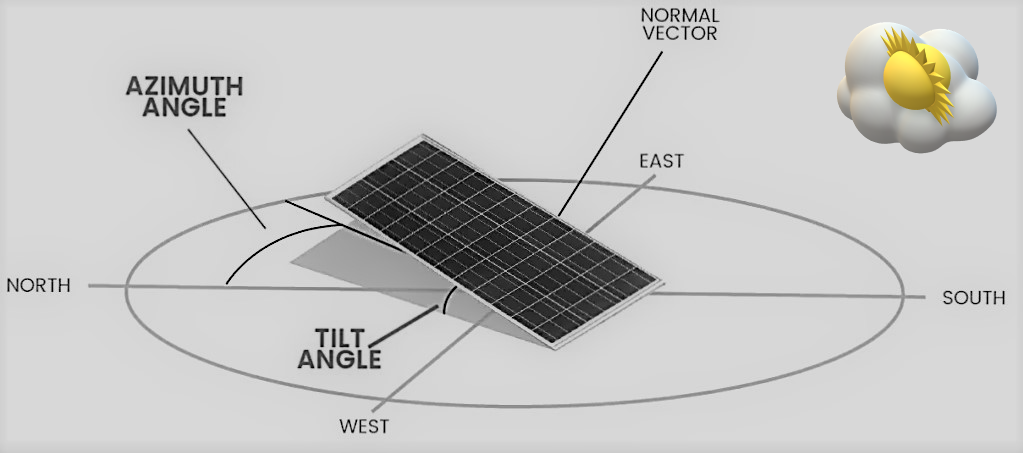
Optimizing Solar Panel Tilt and Orientation for Maximum Efficiency in Different Locations
To get the most energy from the sun, solar panels need to be installed at a specific angle and direction. The ideal angle is when the sun is hitting the panels at a perpendicular angle of 90°. This means the sunlight strikes the panels directly, which produces the most energy.
To achieve this optimal angle, there are two factors to consider: orientation and panel angle. Orientation refers to the direction the solar panels are facing, which can be north, south, east, or west. The panel angle is the angle of the panels from the surface of the Earth.
In different geographic locations, the position of the sun in the sky changes, which means the orientation and panel angle need to be adjusted accordingly. For example, in India, the best angle and direction for solar panels would depend on the specific location. By determining the optimal orientation and panel angle for a specific location, solar panels can be installed to produce the most energy from the sun.
Tilt
The tilt of solar panels refers to the angle at which they are positioned facing the
sky. If solar panels are installed on a flat roof, the tilt would be 0°, but if they were facing a wall, the tilt would be 90°. To determine the optimal tilt for solar panels, the main loads and seasons must be considered. If the main energy loads occur in winter when solar availability is low, the tilt angles should be more vertical. This means that the solar panels should be positioned at an angle approximately equal to the latitude of the location plus 15°. This maximizes the exposure to the low winter sun, which can produce more energy. On the other hand, if the main energy loads are for cooling and refrigeration, the tilt angle should be reduced. This means that the solar panels should be positioned at an angle approximately equal to the latitude of the location minus 10°.
This maximizes the output during the summer when the demand for cooling is higher. For grid-connected solar panel systems, the summer optimum angle should be used to maximize the annual output of the modules. This means that the solar panels should be positioned at an angle that will maximize the energy output throughout the entire year.
Optimizing Solar Panel Orientation in India: Factors to Consider
India is a country located in the northern hemisphere, with latitudes between 6˚ and 36˚N and longitudes between 68˚ and 98˚E. The state of Madhya Pradesh is located between latitudes 21˚ and 27˚N. Each degree of latitude in India is approximately 111 km (69 miles). The terrain of India varies and includes the Deccan plateau, the plains alongside the rivers, the Himalayan Mountain ranges in the north, and the desert area in the west. The southern region of India has a tropical rainy climate, while the northern part is temperate.
To maximize the energy output of solar panels in India, they should be oriented towards the direction that receives the most sunlight. In the northern hemisphere, including India, solar panels should face southwards. However, in the southern hemisphere, such as South Africa, solar panels should be pointed towards the north, which refers to true north rather than the magnetic north indicated by a compass needle.
Magnetic declination is the difference between true north and magnetic north. Fortunately, for India, the magnetic declination is rather small, meaning that the compass needle accurately points towards the direction of geographic north. For example, in Bangalore, as of 2021 magnetic declination was approximately 0.17 degrees west(source: National Oceanic and Atmospheric Administration (NOAA) magnetic field calculator). This small declination allows for greater accuracy when using a compass to determine direction.
Panel Orientation
For fixed tilt angle throughout the year, the angle of the latitude is preferred. This is one fixed orientation where the panel almost always intercepts the greatest amount of solar radiation during the year. However, in general the horizontal tilt of the panels may be adjusted 4 times a year: at the latitude angle in spring and autumn, (Latitude – 15˚) in summer, and (Latitude + 15˚) in winter. Alternatively, one can choose the angle depending upon when the power requirement is greatest. If power shortages are high in summer and the requirement goes high due to the need of running fans, then latitude – 15˚ should be the right choice. Another good way is to adjust angles twice a year for summer and winter seasons. To determine the best panel angles for Bangalore and Dehradun, we need to know their latitudes. Here are the latitude values for both cities:
Bangalore: 12° 58′ 38″ N
Dehradun: 30° 19′ 45″ N
Using the same 15˚ plus/minus rule, we can calculate the optimal panel angles for each city:
For Bangalore, the summer angle will be -3° (12° - 15°) and the winter angle will be 27° (12° + 15°).
For Dehradun, the summer angle will be 15° (30° - 15°) and the winter angle will be 45° (30° + 15°).
Therefore, the best time to adjust the solar panel angle for Bangalore and Dehradun are mid-March and mid-September for the summer angle, and mid-September and mid-March for the winter angle.
If you apply these models for Bangalore and Dehradun, you will get varying angles than the above common rule of ±15˚ compared to latitude. One model even gives a negative angle for Bangalore summer angle, implying slight tilt towards north rather than south! The only point of agreement is that in summer the panels are mounted flatter than latitude and in winter steeper than latitude.